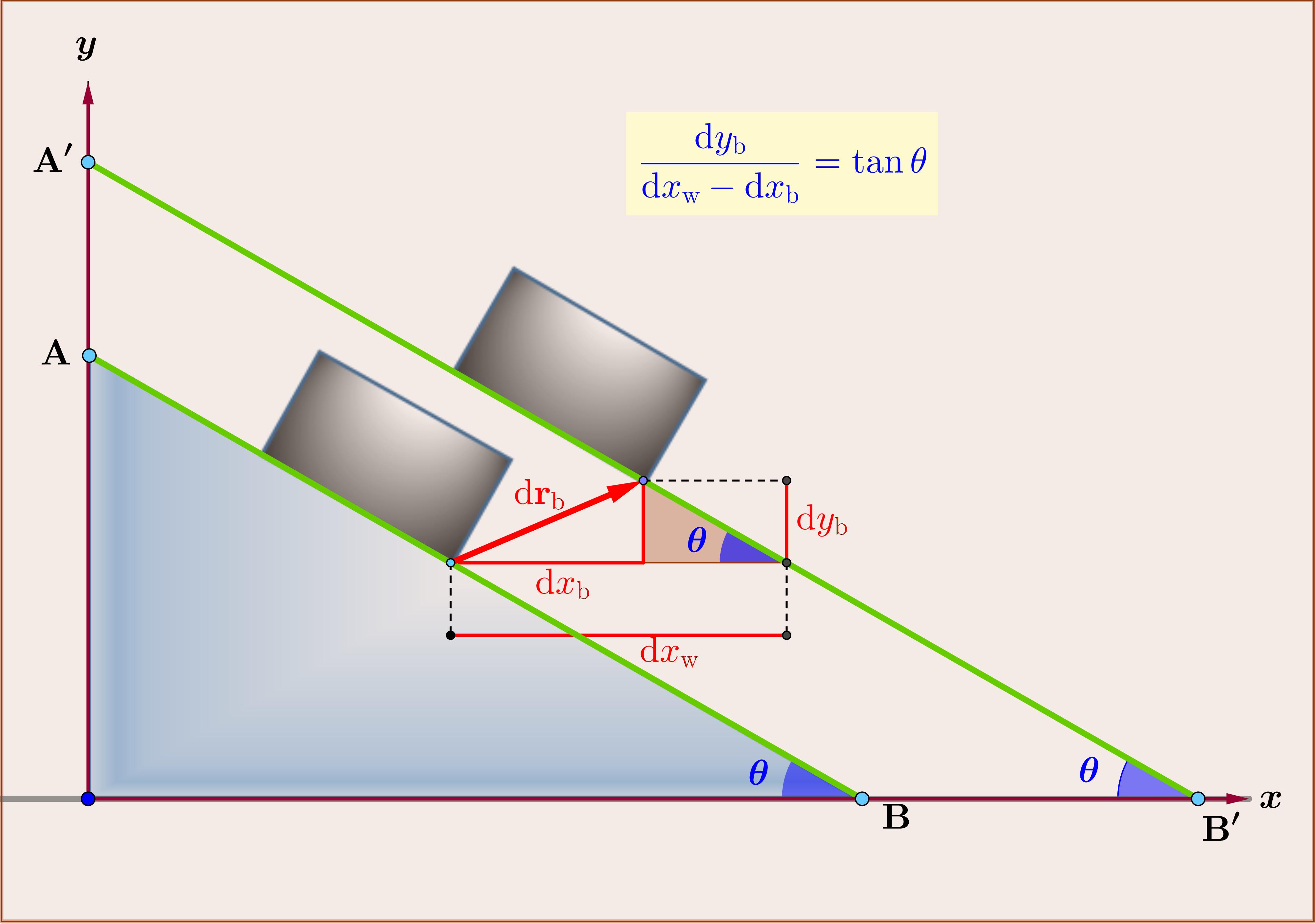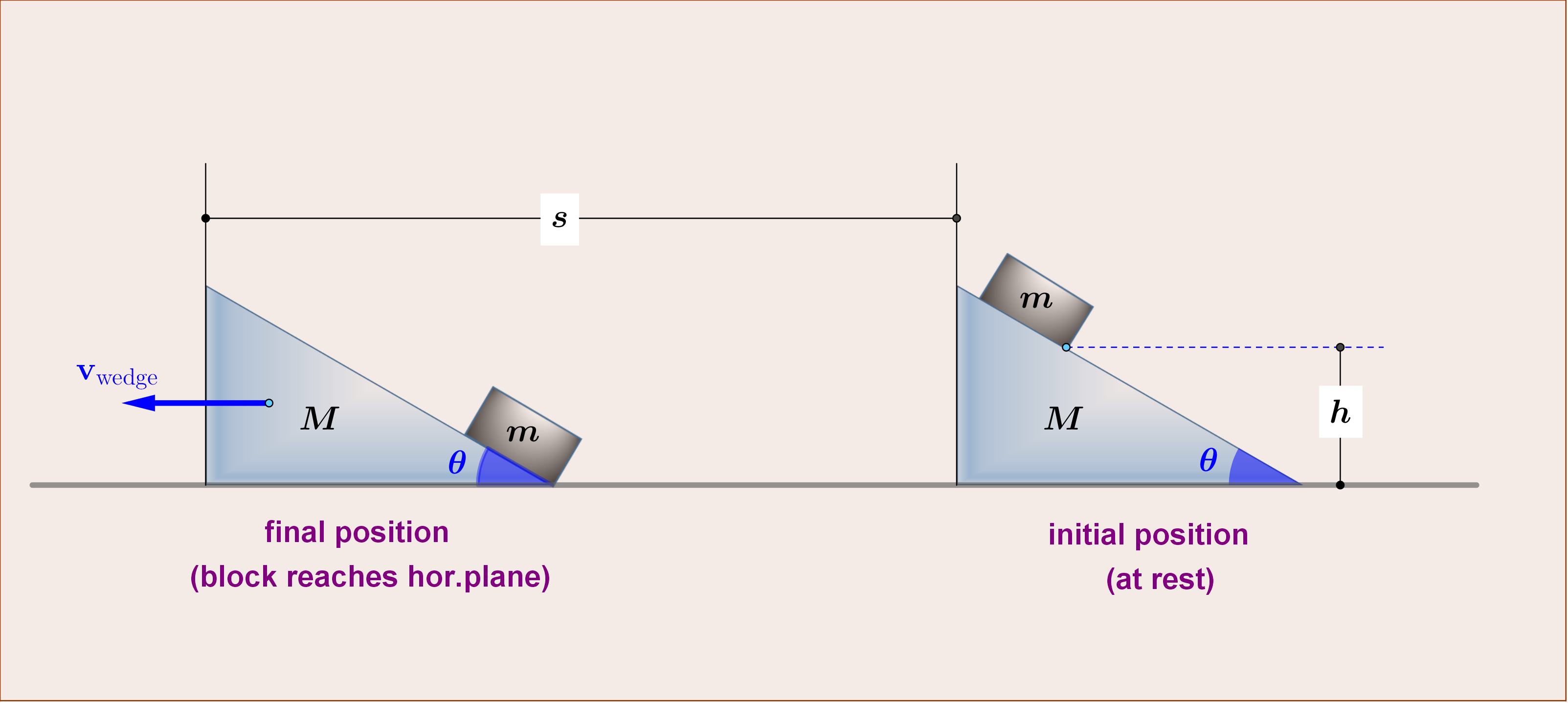1. Wedge-Block System (no friction)
Since the two bodies execute plane translations we'll make use of the following symbols for the position, velocity and acceleration vectors :
\begin{align}
\mathbf{r}_{\mathrm{w}} & = \left(x_{\mathrm{w}},y_{\mathrm{w}} \right)= \text{position vector of a fixed point of the wedge}
\tag{01a}\\
\mathbf{r}_{\mathrm{b}} & = \left(x_{\mathrm{b}},\,y_{\mathrm{b}} \right)= \text{position vector of a fixed point of the block}
\tag{01b}\\
\mathbf{\dot {r}}_{\mathrm{w}} & = \left(\dot{x}_{\mathrm{w}},\dot{y}_{\mathrm{w}} \right)=\left(\dot{x}_{\mathrm{w}},0\right)= \text{velocity of the wedge}
\tag{01c}\\
\mathbf{\dot {r}}_{\mathrm{b}} & = \left(\dot{x}_{\mathrm{b}},\dot{y}_{\mathrm{b}} \right)=\text{velocity of the block}
\tag{01d}\\
\mathbf{\ddot {r}}_{\mathrm{w}} & = \left(\ddot{x}_{\mathrm{w}},\ddot{y}_{\mathrm{w}} \right)=\left(\ddot{x}_{\mathrm{w}},0\right)= \text{acceleration of the wedge}
\tag{01e}\\
\mathbf{\ddot {r}}_{\mathrm{b}} & = \left(\ddot{x}_{\mathrm{b}},\ddot{y}_{\mathrm{b}} \right)=\text{acceleration of the block}
\tag{01f}\\
\mathbf{\ddot {r}}_{\mathrm{bw}} & =\mathbf{\ddot {r}}_{\mathrm{b}}-\mathbf{\ddot {r}}_{\mathrm{w}}=\text{acceleration of the block relatively to the wedge}
\tag{01g}
\end{align}
 For the forces in free-body diagrams, see Figure, we have :
\begin{align}
\mathbf{W} & = \left(0,-Mg\right)= \text{weight of the wedge}
\tag{02a}\\
\mathbf{B} & = \left(0,-mg\right)= \text{weight of the block}
\tag{02b}\\
\mathbf{N} & = \left(N\sin\theta,N\cos\theta\right)=\text{force on block due to wedge}
\nonumber\\
& =-[\text{force on wedge due to block}]
\tag{02c}\\
\mathbf{T} & = \left(0,T\right)=\text{force on wedge due to table}
\tag{02d}
\end{align}
Note that under the no friction assumption the force $\:\mathbf{N}\:$ is normal to the inclination plane while the force $\:\mathbf{T}\:$ is normal to the table.
The equations of motion for the wedge and the block are respectively :
\begin{align}
\mathbf{T}+\mathbf{W}-\mathbf{N} & = M\mathbf{\ddot {r}}_{\mathrm{w}}
\tag{03a}\\
\mathbf{N}+\mathbf{B} & = m\mathbf{\ddot {r}}_{\mathrm{b}}
\tag{03b}
\end{align}
The $\:x$-component of eq.(03a) and the $\:x,y$-components of eq.(03b) give the following scalar equations :
\begin{align}
-N\sin\theta & = M\ddot{x}_{\mathrm{w}}
\tag{04a}\\
N\sin\theta & = m\,\ddot{x}_{\mathrm{b}}
\tag{04b}\\
N\cos\theta - mg & = m\,\ddot{y}_{\mathrm{b}}
\tag{04c}
\end{align}
that is a system of 3 linear equations with 4 unknowns : the three acceleration components $\:\ddot{x}_{\mathrm{w}},\ddot{x}_{\mathrm{b}},\ddot{y}_{\mathrm{b}} \:$ and the force magnitude $\:N$. A 4th equation comes from the geometry of the system and more precisely from the demand the block to be in contact with the wedge and to slide down the wedge at an angle $\:\theta$. This equation is
\begin{equation}
\tan\theta \left(\ddot{x}_{\mathrm{w}}-\ddot{x}_{\mathrm{b}}\right) = \ddot{y}_{\mathrm{b}}
\tag{04d}
\end{equation}
as proved in the end.
For the forces in free-body diagrams, see Figure, we have :
\begin{align}
\mathbf{W} & = \left(0,-Mg\right)= \text{weight of the wedge}
\tag{02a}\\
\mathbf{B} & = \left(0,-mg\right)= \text{weight of the block}
\tag{02b}\\
\mathbf{N} & = \left(N\sin\theta,N\cos\theta\right)=\text{force on block due to wedge}
\nonumber\\
& =-[\text{force on wedge due to block}]
\tag{02c}\\
\mathbf{T} & = \left(0,T\right)=\text{force on wedge due to table}
\tag{02d}
\end{align}
Note that under the no friction assumption the force $\:\mathbf{N}\:$ is normal to the inclination plane while the force $\:\mathbf{T}\:$ is normal to the table.
The equations of motion for the wedge and the block are respectively :
\begin{align}
\mathbf{T}+\mathbf{W}-\mathbf{N} & = M\mathbf{\ddot {r}}_{\mathrm{w}}
\tag{03a}\\
\mathbf{N}+\mathbf{B} & = m\mathbf{\ddot {r}}_{\mathrm{b}}
\tag{03b}
\end{align}
The $\:x$-component of eq.(03a) and the $\:x,y$-components of eq.(03b) give the following scalar equations :
\begin{align}
-N\sin\theta & = M\ddot{x}_{\mathrm{w}}
\tag{04a}\\
N\sin\theta & = m\,\ddot{x}_{\mathrm{b}}
\tag{04b}\\
N\cos\theta - mg & = m\,\ddot{y}_{\mathrm{b}}
\tag{04c}
\end{align}
that is a system of 3 linear equations with 4 unknowns : the three acceleration components $\:\ddot{x}_{\mathrm{w}},\ddot{x}_{\mathrm{b}},\ddot{y}_{\mathrm{b}} \:$ and the force magnitude $\:N$. A 4th equation comes from the geometry of the system and more precisely from the demand the block to be in contact with the wedge and to slide down the wedge at an angle $\:\theta$. This equation is
\begin{equation}
\tan\theta \left(\ddot{x}_{\mathrm{w}}-\ddot{x}_{\mathrm{b}}\right) = \ddot{y}_{\mathrm{b}}
\tag{04d}
\end{equation}
as proved in the end.
Now, we solve this system as follows : From equations (04a),(04b)
\begin{equation}
\ddot{x}_{\mathrm{w}} = -\dfrac{m}{M}\,\ddot{x}_{\mathrm{b}}
\tag{05}
\end{equation}
and
\begin{equation}
N = \dfrac{m}{\sin\theta}\,\ddot{x}_{\mathrm{b}}
\tag{06}
\end{equation}
Inserting (05) in (04d) we have
\begin{equation}
\ddot{y}_{\mathrm{b}}= - \tan\theta\left(1+\dfrac{m}{M}\right)\ddot{x}_{\mathrm{b}}
\tag{07}
\end{equation}
while inserting (06) in (04c)
\begin{equation}
\ddot{y}_{\mathrm{b}}=\dfrac{\ddot{x}_{\mathrm{b}}}{\tan\theta}-g
\tag{08}
\end{equation}
Equating the RHSs of (07),(08)
\begin{equation}
\boxed{\ddot{x}_{\mathrm{b}}=\dfrac{\tan\theta}{1+\tan^{2}\theta \left(1+\dfrac{m}{M}\right)}\,g}
\tag{09}
\end{equation}
which inserted in turn in (07) gives
\begin{equation}
\boxed{\ddot{y}_{\mathrm{b}}= - \dfrac{\tan^{2}\theta \left(1+\dfrac{m}{M}\right)}{1+\tan^{2}\theta \left(1+\dfrac{m}{M}\right)}\,g}
\tag{10}
\end{equation}
so the acceleration vector of the block in the table system (laboratory) is the constant vector
\begin{equation}
\mathbf{\ddot {r}}_{\mathrm{b}} = \left(\ddot{x}_{\mathrm{b}},\ddot{y}_{\mathrm{b}} \right)= \dfrac{\tan\theta }{1+\tan^{2}\theta \left(1+\dfrac{m}{M}\right)}\,g \biggl[1, -\tan\theta \left(1+\dfrac{m}{M}\right) \biggr]
\tag{11}
\end{equation}
with magnitude
\begin{equation}
\Vert\mathbf{\ddot {r}}_{\mathrm{b}}\Vert = \dfrac{\tan\theta\sqrt{1+\tan^{2}\theta \left(1+\dfrac{m}{M}\right)^{2}} }{1+\tan^{2}\theta \left(1+\dfrac{m}{M}\right)}\,g
\tag{12}
\end{equation}
Note that $\:[\:\theta \rightarrow 90^{\rm{o}}\:]\Longrightarrow [\:\mathbf{\ddot {r}}_{\mathrm{b}}\rightarrow \left(0,-g\right)\:]\:$, that is block free fall, as expected.
Now, the acceleration vector of the block relatively to the wedge system is (see Figure below)
\begin{equation}
\mathbf{\ddot {r}}_{\mathrm{bw}}=\mathbf{\ddot {r}}_{\mathrm{b}}-\mathbf{\ddot {r}}_{\mathrm{w}} = \left(\ddot{x}_{\mathrm{b}}-\ddot{x}_{\mathrm{w}},\ddot{y}_{\mathrm{b}} \right)=\left(1+\dfrac{m}{M}\right)\biggl(1, - \tan\theta\biggr)\ddot{x}_{\mathrm{b}}
\tag{13}
\end{equation}
and inserting (09) this is the constant vector
\begin{equation}
\mathbf{\ddot {r}}_{\mathrm{bw}}=\mathbf{\ddot {r}}_{\mathrm{b}}-\mathbf{\ddot {r}}_{\mathrm{w}} = \dfrac{\tan\theta \left(1+\dfrac{m}{M}\right)}{1+\tan^{2}\theta \left(1+\dfrac{m}{M}\right)}\,g\biggl(1,-\tan\theta \biggr)
\tag{14}
\end{equation}
with magnitude
\begin{equation}
\Vert\mathbf{\ddot {r}}_{\mathrm{bw}}\Vert = \Vert\mathbf{\ddot {r}}_{\mathrm{b}}-\mathbf{\ddot {r}}_{\mathrm{w}}\Vert = \dfrac{\sin\theta \left(1+\dfrac{m}{M}\right)}{\cos^{2}\theta +\sin^{2}\theta \left(1+\dfrac{m}{M}\right)}\,g
\tag{15}
\end{equation}

Since in the wedge system the block starting from rest travels rectilinearly a distance $\:s_{\mathrm{bw}}=h/\sin\theta\:$ to reach the table with constant acceleration $\:\Vert\mathbf{\ddot {r}}_{\mathrm{bw}}\Vert\:$ and in time $\:t$, then
\begin{equation}
s_{\mathrm{bw}}=\dfrac{1}{2}\Vert\mathbf{\ddot {r}}_{\mathrm{bw}}\Vert \,t^{2} \quad \Longrightarrow \quad t=\sqrt{\dfrac{2s_{\mathrm{bw}}}{\Vert\mathbf{\ddot {r}}_{\mathrm{bw}}\Vert}}
\tag{16}
\end{equation}
so
\begin{equation}
\boxed{t=\sqrt{\dfrac{1+\tan^{2}\theta \left(1+\dfrac{m}{M}\right)}{\tan^{2}\theta \left(1+\dfrac{m}{M}\right)}}\sqrt{\dfrac{2h}{g}}}
\tag{17}
\end{equation}
Note that for $\:\theta \rightarrow 90^{\rm{o}}\:$ we have, as expected, the time of the block free fall
\begin{equation}
\theta \rightarrow 90^{\rm{o}}\quad \Longrightarrow \quad t\rightarrow t_{\textrm{free fall}}= \sqrt{\dfrac{2h}{g}}
\tag{18}
\end{equation}
Now, the wedge starting from rest travels rectilinearly with constant acceleration $\:\ddot{x}_{\mathrm{w}}\:$ which using equations (05) and (09) is
\begin{equation}
\boxed{\ddot{x}_{\mathrm{w}}=-\dfrac{\left(\dfrac{m}{M}\right)\tan\theta}{1+\tan^{2}\theta \left(1+\dfrac{m}{M}\right)}\,g=-\dfrac{m\tan\theta}{M+\tan^{2}\theta \left(M+m\right)}\,g}
\tag{19}
\end{equation}
Since
\begin{equation}
v_{\textrm{wedge}}=\vert\ddot{x}_{\mathrm{w}}\vert\,t
\tag{20}
\end{equation}
using (17),(19) we have
\begin{equation}
\boxed{v_{\textrm{wedge}}=\dfrac{\left(\dfrac{m}{M}\right)}{\sqrt{{\left(1+\dfrac{m}{M}\right)\biggl[1+\tan^{2}\theta \left(1+\dfrac{m}{M}\right)\biggr]}}}\sqrt{2gh}}
\tag{21}
\end{equation}
The distance traveled by the wedge is
\begin{equation}
s=\dfrac{1}{2}\vert\ddot{x}_{\mathrm{w}}\vert\,t^{2}
\tag{22}
\end{equation}
so
\begin{equation}
\boxed{s=\dfrac{\left(\dfrac{m}{M}\right)}{\tan\theta \left(1+\dfrac{m}{M}\right)}\,h}
\tag{23}
\end{equation}
2. Numerical Values
For $\:\theta = 30^{\rm{o}}\:$ and $\:m/M=1/2\:$ we have
\begin{align}
v_{\textrm{wedge}} & =\tfrac{\sqrt{2}}{3}\,\sqrt{gh} \qquad s =\tfrac{\sqrt{3}}{3}\,h \qquad t =\sqrt{6}\,\sqrt{h/g}
\tag{24a}\\
\ddot{x}_{\mathrm{b}}&=\tfrac{2\sqrt{3}}{9}\,g \qquad \ddot{y}_{\mathrm{b}}=-\tfrac{1}{3}\,g \qquad \Vert\mathbf{\ddot {r}}_{\mathrm{b}}\Vert = \tfrac{1}{3}\sqrt{\tfrac{7}{3}}\, g
\tag{24b}\\
\ddot{x}_{\mathrm{w}}&=\tfrac{\sqrt{3}}{9}\,g \qquad \ddot{y}_{\mathrm{w}}=0\qquad \Vert\mathbf{\ddot {r}}_{\mathrm{w}}\Vert = \tfrac{\sqrt{3}}{9}\,g \qquad \Vert\mathbf{\ddot {r}}_{\mathrm{bw}}\Vert=\tfrac{2}{3}\,g
\tag{24c}
\end{align}
3. Proof of equation (04d)

Suppose that the block is translated infinitesimally by the vector $\:\mathrm{d}\mathbf{r}_{\rm{b}}=\left(\mathrm{d}x_{\rm{b}},\mathrm{d}y_{\rm{b}}\right)\:$
as in Figure. In order for the wedge to be in touch with the block the inclination plane $\:\rm{AB}\:$ must be translated horizontally to $\:\rm{A'B'}\:$ by $\:\mathrm{d}x_{\rm{w}}\:$. But then, as shown in the Figure
\begin{equation}
\mathrm{d}y_{\rm{b}}=\tan\theta \left(\mathrm{d}x_{\rm{w}}-\mathrm{d}x_{\rm{b}}\right)
\tag{25}
\end{equation}
If these translations concern the motion of the system in infinitesimal time $\:\mathrm{d}t\:$ then
\begin{equation}
\dfrac{\mathrm{d}y_{\rm{b}}}{\mathrm{d}t}=\tan\theta \left(\dfrac{\mathrm{d}x_{\rm{w}}}{\mathrm{d}t}-\dfrac{\mathrm{d}x_{\rm{b}}}{\mathrm{d}t}\right) \quad \text{or} \quad \dot{y}_{\mathrm{b}}=\tan\theta \left(\dot{x}_{\mathrm{w}}-\dot{x}_{\mathrm{b}}\right)
\tag{26}
\end{equation}
and differentiating with respect to $\:t\:$
\begin{equation}
\ddot{y}_{\mathrm{b}}=\tan\theta \left(\ddot{x}_{\mathrm{w}}-\ddot{x}_{\mathrm{b}}\right)
\tag{27}
\end{equation}
4. Conservation of energy
In the following we give a proof of the conservation of energy. It's also a verification of the validity of above equations. So we must prove that
\begin{equation}
\dfrac{1}{2}Mv_{\textrm{wedge}}^{2}+\dfrac{1}{2}mv_{\textrm{block}}^{2}=mgh
\tag{28}
\end{equation}
where $\:v_{\textrm{wedge}}^{2}\:$ is given by squaring equation (21)
\begin{equation}
v_{\textrm{wedge}}^{2}=2\dfrac{\left(\dfrac{m}{M}\right)^{2}}{\left(1+\dfrac{m}{M}\right)\biggl[1+\tan^{2}\theta \left(1+\dfrac{m}{M}\right)\biggr]}\,gh
\tag{29}
\end{equation}
and $\:v_{\textrm{block}}^{2}\:$ using equations (12),(17)
\begin{equation}
v_{\textrm{block}}^{2}=\Vert\mathbf{\ddot {r}}_{\mathrm{b}}\Vert^{2} \cdot t^{2}= \dfrac{\tan^{2}\theta\biggl[1+\tan^{2}\theta \left(1+\dfrac{m}{M}\right)^{2}\biggr] }{\biggl[1+\tan^{2}\theta \left(1+\dfrac{m}{M}\right)\biggr]^{2}}\,g^{2} \cdot\dfrac{\biggl[1+\tan^{2}\theta \left(1+\dfrac{m}{M}\right)\biggr]}{\tan^{2}\theta \left(1+\dfrac{m}{M}\right)}\dfrac{2h}{g}
\tag{30}
\end{equation}
so
\begin{equation}
v_{\textrm{block}}^{2}=2\dfrac{\biggl[1+\tan^{2}\theta \left(1+\dfrac{m}{M}\right)^{2}\biggr] }{\left(1+\dfrac{m}{M}\right)\biggl[1+\tan^{2}\theta \left(1+\dfrac{m}{M}\right)\biggr]}gh
\tag{31}
\end{equation}
From (29)
\begin{equation}
\dfrac{1}{2}Mv_{\textrm{wedge}}^{2}=\dfrac{\dfrac{m}{M}}{\left(1+\dfrac{m}{M}\right)\biggl[1+\tan^{2}\theta \left(1+\dfrac{m}{M}\right)\biggr]}\,mgh =\alpha\cdot mgh
\tag{32}
\end{equation}
and from (31)
\begin{equation}
\dfrac{1}{2}mv_{\textrm{block}}^{2}=\dfrac{1+\tan^{2}\theta \left(1+\dfrac{m}{M}\right)^{2}}{\left(1+\dfrac{m}{M}\right)\biggl[1+\tan^{2}\theta \left(1+\dfrac{m}{M}\right)\biggr]}\,mgh =\beta\cdot mgh
\tag{33}
\end{equation}
where
\begin{align}
\alpha & = \dfrac{\dfrac{m}{M}}{\left(1+\dfrac{m}{M}\right)\biggl[1+\tan^{2}\theta \left(1+\dfrac{m}{M}\right)\biggr]}
\tag{34a}\\
\beta & = \dfrac{1+\tan^{2}\theta \left(1+\dfrac{m}{M}\right)^{2}}{\left(1+\dfrac{m}{M}\right)\biggl[1+\tan^{2}\theta \left(1+\dfrac{m}{M}\right)\biggr]}
\tag{34b}
\end{align}
But
\begin{equation}
\alpha + \beta = 1
\tag{35}
\end{equation}
so proving the conservation of energy, equation (28).




